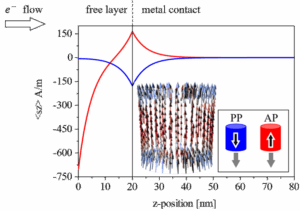We simulated the current-induced switching of magnetization of short vertical magnetic nanopillars as the free layer in a magnetic tunnel junction. Considering spin accumulation is crucial in such 3D elements, leading to an enhancement of the field-like torque, and the excitation of non-uniform FMR modes.

Spin accumulation in the 3D free layer and in the metal contact for both parallel and antiparallel configurations with respect to the reference layer of the magnetic tunnel junction. The flower state of the 3D free layer is displayed in the inset.
3D nanomagnetism is a fast-growing topic, motivated by fundamental physical effects arising from curvature such as effective anisotropy or Dzyaloshinskii-Moriya interaction, the respective topologies and chiralities of magnetization distributions versus those of the underlying nanostructures, or enhanced magnetostatics. So far, most effects investigated concerned the distribution of magnetization, either in static of dynamic conditions. In contrast, specificity of spintronics effects in 3D nano-elements have rarely been mentioned, while this would be desirable in the context of the push of information / communication technology towards integrated 3D devices to ever improve performances. An example in spintronics is the concept of Perpendicular Shape Anisotropy Magnetic Random Access Memory, proposed and demonstrated independently by Tohoku University and SPINTEC. Its storage layer consists of a short pillar, whose vertical aspect ratio is the main source of perpendicular anisotropy, and the much-increased volume allows to sustain thermal stability down to a few nanometers in diameter.
We have considered a cylindrical nanopillar as the free layer of a Perpendicular Shape Anisotropy Magnetic Random Access Memory, bounded by the tunnel barrier at one interface and the metal lead at the other interface. We have simulated self-consistently the coupled dynamics of the spin accumulation and the resulting magnetization dynamics. Several specific features were identified. First, the gradual decay of spin accumulation along the depth of the pillar results in a field-like torque equal in magnitude to the damping-like torque. Second, the magnetization canting at the edges of the pillar, in the so-called flower state, induces a sizable torque from the very beginning of the current pulse. This reduces the incubation time and can even lead to a qualitative change of the switching behavior, from the usual macrospin to a curling type, promoted by the emergence of a non-uniform ferromagnetic resonance mode with rotational symmetry.
The simulations conducted show that specific spintronic features are to be expected in 3D nanosystems. First, it may be crucial to compute explicitly spin accumulation and derive the resulting components of the spin-transfer torque, while the consideration of effective torques and neglecting the field-like torque such as usually done in flat magnetic cells may be erroneous. Besides, specific modes of magnetization switching may arise, promoted by the enhanced 3D magnetostatic effects. Both may provide opportunities to optimize the emerging 3D spintronics devices in terms of speed and power consumption.
Teams: Spin Textures, MRAM, Theory/Simulation
Further reading: Simulation of current-driven magnetization switching in nanopillars with perpendicular shape anisotropyipole-coupled core-shell perpendicular-shape-anisotropy magnetic tunnel junction with enhanced write speed and reduced crosstalk, N. Boscolo Meneguolo, O. Fruchart, J.C. Toussaint, M. Fattouhi, L. Buda-Prejbeanu, I.L. Prejbeanu, D. Gusakova, Phys. Rev. B 112, 014448 (2025). Open access: hal-04999028
Contact: Daria Gusakova, Olivier Fruchart




